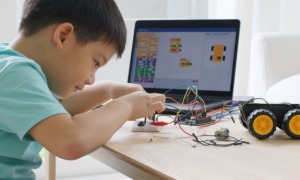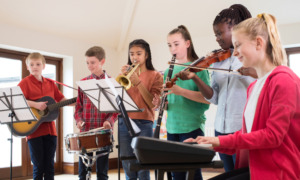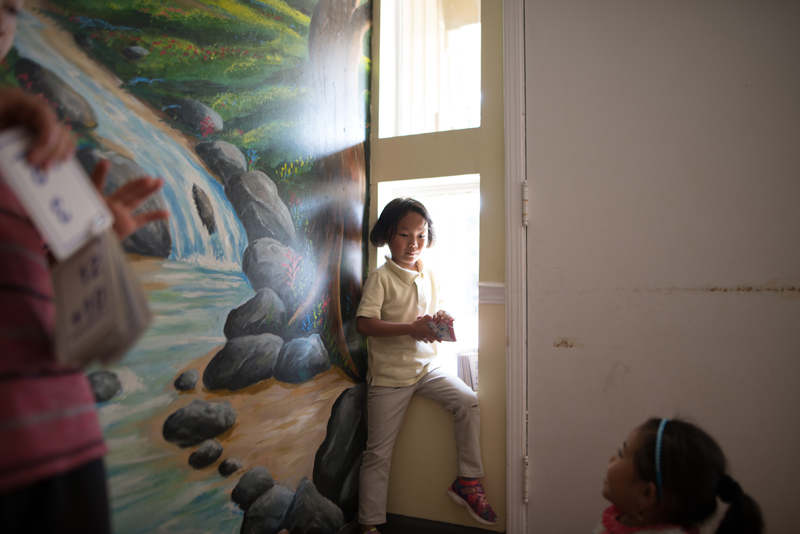
Photos by Ali Sardar
The after-school program at the Willow Branch complex in Clarkston.
CLARKSTON, Ga. — Children shoulder their book bags as they stream out of Indian Creek Elementary School at 2:30 each day. They walk in twos or threes toward their apartments.
They are Asian, African, European and American, speaking many different languages.
Down the street from the school, a driveway curves into the Willow Branch apartment complex. Like the surrounding apartments, it houses international refugees who have been resettled in this Atlanta suburb.
But Willow Branch is different from the others.
It offers services to residents funded through Star-C, a nonprofit created by Willow Branch landlord Marjy Stagmeier of TriStar Real Estate Investment. Star-C is testing whether affordable housing, affordable medical care and a free on-site after-school program can stabilize the families and reduce transiency at Indian Creek Elementary.
As refugees, the residents face many obstacles, especially financial ones. The average household income is $18,750.
At Willow Branch, they are guaranteed a stable rent and assistance in finding an affordable health care provider. They also have access to garden plots. The goal is to provide them with stability and ultimately turn around Indian Creek Elementary School.
Star-C Program Manager Allie Reeser, a young woman with blonde hair and glasses, stands near a boarded-up fireplace in the complex’s clubhouse, a pine-paneled room behind the leasing office. She runs the after-school, health and gardening programs.
Outside the building, four children bounce a red rubber ball on a square of concrete. Others play on the grass or wander in pairs toward the after-school program in the clubhouse.
Soon Reeser will call the 45 or so kids inside to do homework.
“A lot of them just need to unwind,” she said.
Gardens and health
Across the wide lawns of the complex are small vegetable gardens. Located next to apartment units, they are planted in beans, squash and roselle, a leafy green eaten in Asia.
On some Saturdays, Reeser organizes a health education event. A dentist recently came and talked to the children about how to take care of their teeth. She connects families to Oakhurst Medical Center, a federally supported clinic with six locations around Atlanta.
“Sometimes I drive people. Sometimes Oakhurst sends a van,” she said.
Low-income households have high relocation rates, and housing instability has become a huge issue for people with low incomes. Those under the poverty level move at twice the rate of those above it, often forced out by inability to pay and landlords aggressive in evicting them.
The biggest determinant of failing schools is the transiency of children and families in poverty, according to Stagmeier.
[Related: After-school Programs Offer Protective Factors, Research Shows]
The simple after-school program at Willow Branch has as many as 65 kids on some days.
“If they don’t have homework, they do flash cards,” Reeser said.
In a small kitchen, multicolored juice glasses sit on a table under a pink bulletin board. Kids’ Polaroid headshots are pinned neatly on the board, each one labeled. It’s a poetry of names: Niharika, Salma, Ri Mu Lar, Yonas and Yassin. Pramisha, Fabi, Somaya, Pacifique and Mohamad.
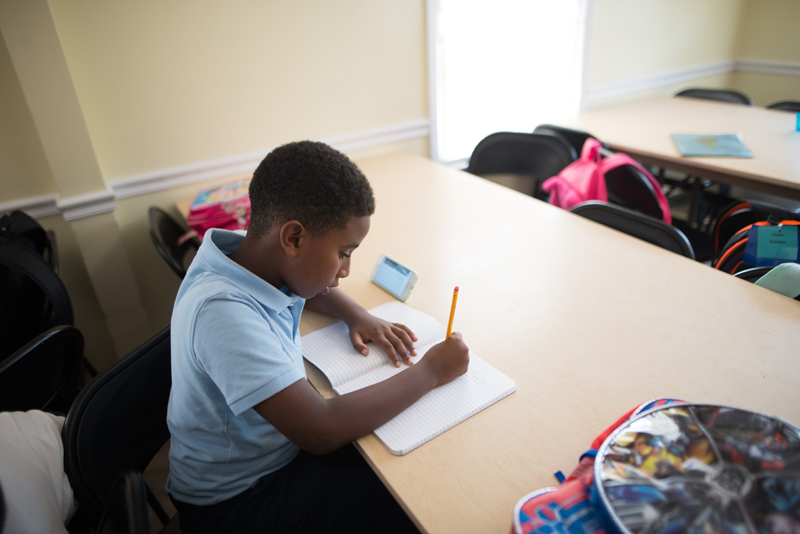
Child doing his homework at after-school program.
“In my class I’m the smartest one,” volunteers a third-grade girl.
Her parents came from Burundi, but she was born here. She has a brother and sister born in Africa.
A first-grader from Burma asks for help with math. She says she can’t read.
After homework, the kids line up to get juice and a piece of fruit, handed out by the older girls. Then Reeser reads a story to the whole group.
Despite the large number in the small space, the kids aren’t bouncing off the walls.
Reeser, who also lives in the complex, describes her refugee neighbors.
“They have a sense of self-responsibility,” she said. “The education of the children is extremely important.” Parents will take advantage of every opportunity, she said. Most are two-parent families with both parents in jobs.
The majority of residents at Willow Branch have refugee status, which means they fled conflict or persecution in their home countries and found asylum in the United States.
Education obstacles
While education is important to them, the school in their neighborhood has been among the worst performing in Georgia.
Indian Creek Elementary received an F in 2013 from the Georgia Office of Student Accountability. Today it has a grade of C.
The school has done a lot to improve, pinpointing students’ needs and providing them with specific help, Reeser said. “But we’re a part of that,” she said.
“Literacy is a huge challenge” for the after-school program, she said. Parents often don’t speak much English and the children’s only English interactions are at school, she said. They may be in large classes, reducing their opportunity to practice speaking English.
“It’s hard to get up to the skill level,” she said. “Even access to books can be a challenge.”
The after-school program provides children a safe place to be, socializes them in American ways and helps them learn English. It offers homework help that non-English-speaking parents can’t provide.
After-school programs have also been shown to improve kids’ engagement in school and improve their attendance.
“We have a real sense they’re doing better than other students [at Indian Creek],” Reeser said.
On the end-of-the-year Georgia Milestones test “we have a better pass rate than the school as a whole,” she said. But actual impact is hard to measure, since the school does not make test scores available to the after-school program. Reeser relies on children and parents bringing their test and scores to her.
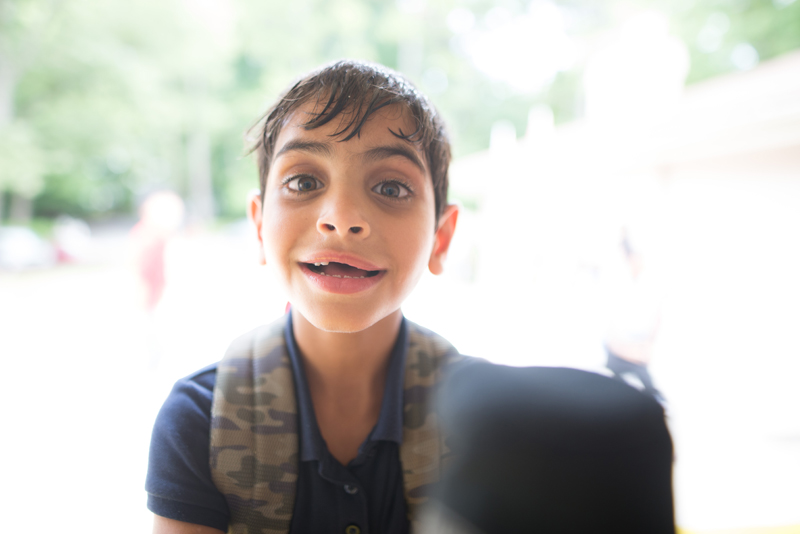
Child in the Willow Branch after-school program.
Willow Branch kids make up 9 percent of the school population at Indian Creek Elementary, according to Audrea Rease, executive director of Star-C.
“We do what we can with our students to reduce transiency and help them perform better,” she said.
The school could be impacted if the other 11 apartment complexes would keep their transiency down and offer services,” Rease said.
A tough job to marshall evidence
Measuring the after-school program’s effect on the school could be a sticking point for Star-C, however. Although the school’s transiency rate is measurable, the Willow Branch program can’t reliably show an academic impact without access to school data.
A general way to measure impact of an after-school program is to match the young people in the program with a similar group (in age, gender, ethnicity, etc.) not in the program. Then compare such things as test scores or school attendance.
If an after-school program is working directly toward certain academic goals, “it’s reasonable to see a change in test scores,” said Jessy Newman, senior researcher for youth development at the American Institutes for Research.
Even with data, the Willow Branch program would find it difficult to link its students’ improvement with any change in the school overall. Too many other factors can explain a change in school performance.
The program, however, could show that it meets other important goals.
Newman said that before considering impact, it’s important to clarify goals and how a program is structured to reach them. Determine what you care about, what you’re actually doing in the program and what is reasonable to expect from it, she said.
“You could do interviews and focus groups and look for those things and report on them. It’s a fairly robust way of qualitatively talking about the effect of the program,” she said. You could ask a similar set of questions to kids, parents and staff to get answers about what they find most beneficial in the program, she said.
“It helps them talk about the value in a way that is truly meaningful,” Newman said. “It’s often my recommendation.”
The ingredients of stability
The goal of Star-C is wider than the after-school program. It is to improve the stability of Willow Brook residents, which Stagmeier believes will be reflected in an improved school.
When Stagmeier decided to see if services at the apartment could impact the school, she went to see then-principal Antonette Campbell. Stagmeier asked her what was needed.
Health care for kids was the answer. Then Stagmeier learned about federally qualified health centers, clinics funded by the federal Health Resources & Services Administration that provide care in underserved areas. One is Oakhurst Medical Centers, which bills patients on a sliding scale based on their income.
Today Star-C focuses on helping residents navigate the health care system and get connected with a clinic such as Oakhurst.
Star-C also began encouraging household gardens several years ago.
“Refugees here know how to garden already,” Reeser said.
The plots provide a source of familiar foods and offer exercise and stress reduction, according to Star-C. And when adults spend time outside in the garden, their presence is a deterrent to crime. They are “eyes on the street,” in the words of Jane Jacobs, whose book “The Death and Life of Great American Cities” held that a range of uses in public space kept people in them and made the spaces safer.
Reeser is sold on the value of the services provided at Willow Brook. Residents have resources they wouldn’t otherwise have, and the services empower residents, she said.
“They know that they have someone who’s an ally there,” she said. “Star-C offers a huge confidence boost and is truly changing these communities.”
Related articles:
After-school Director Allie Reeser Has Quiet Presence, Strong Purpose
Tougher Rules Force Out Residents With Warrants, But Help Students’ Grades
Can After-school Program at Apartment Complex Turn Around a Failing School?


